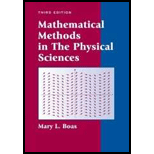
Concept explainers
Assume from electrodynamics the following equations which are valid in free space. (They are called Maxwell’s equations.)
Want to see the full answer?
Check out a sample textbook solution
Chapter 13 Solutions
Mathematical Methods in the Physical Sciences
Additional Math Textbook Solutions
Mathematics with Applications In the Management, Natural, and Social Sciences (12th Edition)
Calculus for Business, Economics, Life Sciences, and Social Sciences (14th Edition)
Differential Equations: An Introduction to Modern Methods and Applications
Introductory Mathematics for Engineering Applications
Finite Mathematics for Business, Economics, Life Sciences and Social Sciences
- Let x=x(t) be a twice-differentiable function and consider the second order differential equation x+ax+bx=0(11) Show that the change of variables y = x' and z = x allows Equation (11) to be written as a system of two linear differential equations in y and z. Show that the characteristic equation of the system in part (a) is 2+a+b=0.arrow_forwardDefine T:R2R2 by T(v)=projuv Where u is a fixed vector in R2. Show that the eigenvalues of A the standard matrix of T are 0 and 1.arrow_forward
 Linear Algebra: A Modern IntroductionAlgebraISBN:9781285463247Author:David PoolePublisher:Cengage LearningAlgebra & Trigonometry with Analytic GeometryAlgebraISBN:9781133382119Author:SwokowskiPublisher:Cengage
Linear Algebra: A Modern IntroductionAlgebraISBN:9781285463247Author:David PoolePublisher:Cengage LearningAlgebra & Trigonometry with Analytic GeometryAlgebraISBN:9781133382119Author:SwokowskiPublisher:Cengage Elementary Linear Algebra (MindTap Course List)AlgebraISBN:9781305658004Author:Ron LarsonPublisher:Cengage Learning
Elementary Linear Algebra (MindTap Course List)AlgebraISBN:9781305658004Author:Ron LarsonPublisher:Cengage Learning


